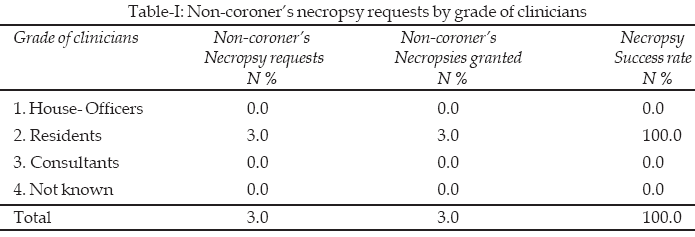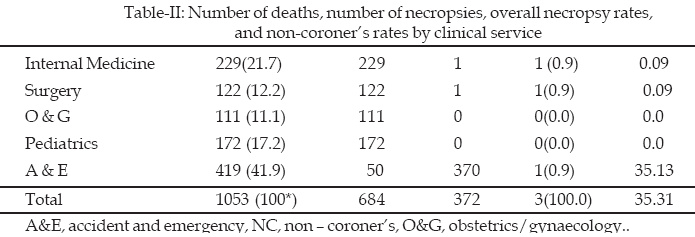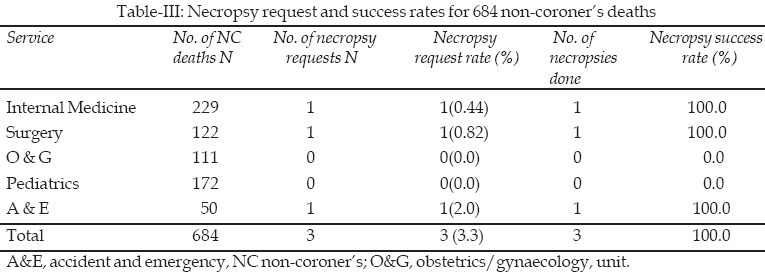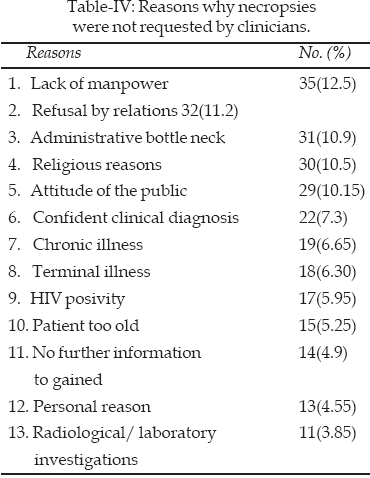|
|
||||
|
Published by : PROFESSIONAL MEDICAL PUBLICATIONS |
||||
|
ISSN 1681-715X |
||||
|
||||
|
|
||||
|
- |
||||
|
ORIGINAL ARTICLE |
||||
|
- |
||||
|
Volume 25 |
July - September 2009 |
Number 4 |
||
|
|
||||
|
||||
|
|
||||
|
Published by : PROFESSIONAL MEDICAL PUBLICATIONS |
||||
|
ISSN 1681-715X |
||||
|
||||
|
|
||||
|
- |
||||
|
ORIGINAL ARTICLE |
||||
|
- |
||||
|
Volume 25 |
July - September 2009 |
Number 4 |
||
|
|
||||
|
||||
Necropsy request behaivour of clinicians:
A study from a university teaching hospital in Nigeria
Agboola AOJ1, Izegbu MC2, Oyebadejo TY3
ABSTRACT
Objectives: To investigate necropsy request practices at the Olabisi Onabanjo University Teaching Hospital, Sagamu and to determine the extent to which these might influence the declining necropsy rates.
Methodology: The necropsy service was audited retrospectively over a fifteen-month period and data relating to non-coronerís (hospital) necropsy requests, including the clinical service were extracted from the death register of the department of Morbid Anatomy and Histopathology, Olabisi Onabanjo University Teaching Hospital and documented. The reasons for non-request were recorded for deaths in which a necropsy was not requested. A cross-sectional study of clinicians was conducted at an Academic Staff Assembly of Obafemi Awolowo College of Health Sciences, Olabisi Onabanjo University, Sagamu, held in August 2007, using a standardized randomly self-administed questionnaire
Results: There were 1053 deaths comprising 684 non-coronerís and 369 coronerís cases. The overall, non-coronerís, and coronerís necropsy rates were 35.3%, 3.3%, and 99.2% respectively. The non-coronerís necropsy request rate was 33.3% with success rate of 100%. Residents doctor made all the requests and the internal medicine service, which accounted for most of the non-coronerís death; the necropsy requests rate of 33.3% was the same for Surgery and Accident and Emergency units. Lack of manpower, diagnosis was the main reason for not requesting a necropsy.
Conclusions: These findings show a relatively high necropsy success rate in the face of abysmally low necropsy request rate, and indicate that necropsy rates can be increased if clinicians make more necropsy requests in a timely manner in all patients.
KEY WORDS:
Necropsy request, Clinicians Behaivour.Pak J Med Sci July - September 2009 Vol. 25 No. 4 650-655
How to cite this article:
Agboola AOJ, Izegbu MC, Oyebadejo TY. Necropsy request behaivour of clinicians: A study from a university teaching hospital in Nigeria. Pak J Med Sci 2009;25(4):650-655.
1. AOJ Agboola ,
2. MC Izegbu,
Departments of Morbid Anatomy,
3. TY Oyebadejo,
Department of Histopathology,
1-3: Olabisi Onabanjo University Teaching Hospital,
PMB 2022, Sagamu, Nigeria.
Correspondence
Dr. Agboola AOJ,
E-mail: johndeji2001@yahoo.co.uk
* Received for Publication: May 23, 2008
* Accepted: June 25, 2009
INTRODUCTION
Despite consistent confirmation of the importance of the necropsy in the practice of modern medicine, necropsy rates have shown a worldwide decline over the past several decades.
1-6 Recently, we examined our necropsy rates at the Olabisi Onabanjo University Teaching Hospital from 1996-2004.The factors contributing to declining necropsy rates have been examined and discussed in several reports from developed countries, and can be broadly grouped to include administrative policies, the attitudes of the medical profession, manpower, and the attitudes of the public.
7-12 Where the medical profession is concerned, it is well recognized that the number of hospital necropsies performed at any institution depends heavily on requests being made by the relevant clinicians, and that inappropriate delegation of clinical necropsy requests to the most junior clinicians has contributed to falling necropsy rates.13 Therefore, we decided to conduct a retrospective audit of our hospital necropsy services in an attempt to establish a possible link between our declining necropsy rates and necropsy practice of our clinicians. We also sought to document the necropsy success rateTo the best our knowledge, this study represents the first of such report from Nigeria.
METHODOLOGY
Our study took the form of an audit of the necropsy service of the department of Morbid Anatomy and Histopathology, which retrospectively examined data related to deaths and autopsies at the Olabisi Onabanjo University Teaching Hospital. It is a 240 bedded, multi-displinary teaching hospital attached to the Obafemi Awolowo College of Health Sciences, Olabisi Onabanjo University, in Sagamu- over the fifteen period from June 2006 to August 2007.
A cross-sectional study of clinicians was conducted at an Academic Staff Assembly of Obafemi Awolowo College of Health Sciences, Olabisi Onabanjo University, Sagamu, held in August 2007, using a standardized randomly self-administed questionnaire. It was designed to enquire about the clinical service under which the patient was managed, the relevant clinical diagnosis, and whether or not a necropsy was requested. If requested, the position of the relevant clinician was recorded and, if not, we documented the reason given for not requesting the necropsy.
The information regarding necropsy requests was extracted for non-coronerís necropsies only from the death register since Coronerís (Medico- legal) necropsies are mandatory in our institution.
These data were used to calculate the following:
*
The overall necropsy rate for the study period- the number of necropsies performed as a percentage of the total number of deaths.*
The non-coronerís necropsy rate- the number of non- coronerís necropsies performed as a percentage of the number of non-coronerís deaths*
The coronerís necropsy rate Ė the number of coronerís necropsies performed as a percentage of the total number of necropsies performed.*
The necropsy request rate-the number of non-coronerí necropsies requested as a percentage of the total number of non-coronerís requested.*
The necropsy success rate-the number of non-coronerís necropsies performed as a percentage of the number of non-coronerís necropsies requested.Statistical Analysis: The results are presented using tables and collected data were analyzed using Microsoft- Excel software.
RESULTS
The total number of deaths for the fifteen month study period was 1053 namely, 684 non- coronerís cases and 369 coronerís cases. There were 595 male and 458 female patients giving a male to female ratio, 1.3: 1.The age ranged from one day to 97 years. However, the age of two female patients were unknown. Documented hospital rates of autopsy of 3.6% which was low compared with international rates which are reported as at least 10%.
14The results show that 17 questionnaires were sent out representing 44.73% of the clinicians that deposited corpses in the mortuary. Thirteen of the questionnaires were returned giving a responds rate of 76.5%. Records show that 684 non- coroners deaths were received from the various units of the hospital: Surgery (122), Obstetrics and Gynaecology (111), Medicine (229), Accident and Emergency (50) and Pediatrics (172).
Tables-I shows the resident doctors request for necropsies with the permission of their consultants.

Table-II presents the overall figures for deaths and necropsies by service. The total number of necropsies requested during this period was 372, giving an overall necropsy rate of 35.3%. The coronerís necropsy rate was 99.2% and non-coronerís necropsy rate was 0.44%. The largest number of deaths occurred under the internal medicine service, which had the lowest request rates of 0.44%, followed by surgical (0.82%) and accident and emergency departments (2.0%).

Table-III shows the necropsy request and success rates for the three non-coronerís cases by service. The necropsy request rate was 0.44% for internal medicine, 0.82% for surgery and 2.0 % for accident and emergency. The overall necropsy success rate was 100.0%.

Table-IV shows that the main reason for not requesting for autopsy in our center was lack of man-power (12.25%) followed closely, in order of importance by, refusal by relations (11.2%), Administrative bottle neck (10.85%), religious reasons (10.5%), attitude of the public (10.15%), confident clinical diagnosis (7.30%), chronic illness (6.65%), terminal illness (6.30%), HIV positivity (5.95%). Patient too old (5.25%), no further information to be gained (4.9%), personal reasons (4.55%) and radiological/ laboratory investigations (38.5%).

DISCUSSION
Necropsy rates in Nigeria have shown a consistent decline over the past three decades,
15 and the data from our study demonstrate a continuation of this trend, with an overall necropsy rate of 35.3% and an overall non-coronerís necropsy request rate of 3.3%. This is similar to the trend that has been reported worldwide and various reasons have been offered to explain this, including poor necropsy request practices.1,2,7,13,16 Our study is the first to document necropsy request practices in our institution and we could not find similar reports from developing countries such as ours.The highest non-coronerí necropsy rate were seen for the accident and emergency, surgical and internal medicine and these services also had the highest request rates. In contrast, internal medicine, in which most deaths occurred, had the lowest non-coroners necropsy rate and the Accident and Emergency with the lowest number of death and has the highest necropsy rate. These data show inverse relationship between the number of non-coronersí death and request rate in our institution, which does not support the direct link between the two variables that was documented elsewhere.
17The low non-coroners necropsy request rate did not permit us to analyze the necropsy request in relation to patientsí age but experience has shown that there was significantly greater likelihood for necropsies to be requested in younger versus older patients, although, a few of the deaths occurred in aged and very often, clinicians write "old age" as cause of death. This is wrong and should be discouraged. Studies have shown a similar trend
3,18,19 and as suggested by Ahronheim et al19 the death of elderly patients are more likely to be attributed to Ďnatural causesí, despite there being significant discordance between clinical and post-mortem diagnoses when necropsies are performed in this age group.Residents made most of the necropsy requests (100.0%), which is not surprising because they are responsible for the day to day management of patients in the wards. These results are similar to those of Start et al
18 who reported that house officers, senior house officers, and registrar (the equivalent of our residents) made most of the requests, whereas consultants requested the smallest proportion. Data from this study do not measure the degree of consultant supervision of this process, but it is accepted that it is the responsibility of the consultants to obtain permission for the performance of necropsies.8 Even if this responsibility is allocated to junior staff they should be trained to approach relatives in a sensitive and informed manner, which would maximize the likelihood of obtaining consent. The overall necropsy request rate was low but, once requested, necropsies stood a good chance of being done, with an overall success of 100%.Analysis of the reason obtained for the non-request of necropsies pointed strongly to lack of manpower. This was followed closely by refusal by relations to give consent, which is in line with other studies that have documented an unwillingness of relatives to provide consent in up to 69% of cases.
20,21 Administrative bottle neck was the third most common reason for non-request of necropsy which is followed by religious reasons, attitude of the public, confident clinical diagnosis, chronic illness, terminal illness, patient too old, no further information to be gained, personal reasons and radiological/ laboratory investigations. This was despite the fact that it has been well documented that advances in imaging and other diagnostic technology have not significantly altered the rates of clinical and necropsy discordance over the past several decades.22-25The results of our study are similar to those previously reported from developed countries. If our necropsy rates are to attain recommended international standards, our data suggest that clinicians should be educated as to the value of the necropsy with a view to improving their non-coronerís necropsy request rates. This might entail implementing some of the recommendation made by Sinard and Blood.
26 In developing countries, the importance of hospital guidelines for non-coronerís necropsies must be emphasized. Failure to deal with these issues will probably result in the continuing decline of necropsy, with the concomitant loss of all of its potential benefits.In conclusion, the necropsy remains an important form of medical audit, while providing avenues for medical education and research. Despite this, we have documented low overall and non-coronerís necropsy request rates, which varied across clinical services in contrast to the success rate, which was uniformly high. Non-consultant clinicians (residents) requested for all of the necropsies. Where reasons were obtained for the non-request of necropsies, it was mostly related to lack of manpower followed closely by refusal by the relations to give consent.
ACKNOWLEDGMENTS
We are grateful to our colleagues at the Academic Staff Assembly of Obafemi Awolowo College of Health Sciences, Olabisi Onabanjo University, Sagamu, for sparing their time to fill the questionnaires.
REFERENCES
1. Nemetz PN Ludwig J, Kurland LT. Assessing the autopsy. Am J Pathol 1987;128:362-79.
2. Anderson NH, Shanks JH, McCluggage GW. Necropsies in clinical audit. J Clin Pathol 1989;42:897-901.
3. Cameron HM, McGoogon E, Clarke J. Trends in hospital necropsy rates, Scotland 1961 Ė 74. BMJ 1977;1:577-80.
4. Waldron HA, Vickerstaff I. Necropsy rates in the United Birmingham Hospitals BMJ 1975;2:326-8.
5. Sanner MA. In perspective of the declining autopsy rate. Attitude of the public. Arch Pathol Lab Med 1994;118:878-83.
6. Wood MJ. Guha AK. Declining clinical autopsy rates versus increasing mediolegal autopsy rates in Halifax, Nova Scotia. Arch Pathol Lab Med 2001;125:924-30.
7. Escoffery CT. Shirley SE. Autopsy rates at the University Hospital of the West Indies. 1968 Ė 1997. West Indian Med J 2000;49:164-8.
8. Joint Working Party of the Royal College of Pathologists, the Royal College of Physicians of London and the Royal College of Pathologists, the Royal College of Physicians of London and the Royal College of Surgeons of England. The autopsy and audit, London: Royal College of Physicians of London and the Royal College of Pathologists, the Royal College of Physicians of London and the Royal College of Surgeons of England.www.rcpath.org/activities/publications/aa book.html 1991:3-5.
9. Valaske MJ. Loss control/risk management. A survey of the contribution of autopsy examination. Arch Pathol Lab Med 1984;108:462-8.
10. Friederici HH, Sebastian M. An argument for the attendance of clinicians at autopsy. Arch Pathol Lab Med 1984;108:522-3.
11. Shimizu M, Hirokawa M, Matsumoto T. Manpower is another influential factor of necropsy rate. J Clin Pathol 1998;51:83.
12. Brown HG. Perceptions of the autopsy views from the public and program proposals. Hum Pathol 1990;21:154-8.
13. Start RD. Brain SG, McCulloch TA. Analysis of necropsy request behavior of clinicians. J Clin Pathol 1996;49:29-33.
14. Abudu EK, Banjo AAF, Izegbu MC, Agboola AOJ, Anunobi CC. An Audit of Autopsy Practice- Olabisi Onabanjo University Teaching Hospital (OOUTH), Sagamu Experience, Nigerian Medical Practitioner 2006;49,4:88-91.
15. Dada-Adegbola HO, Thomas JO. Autopsy an audit Tool; University college Ibadan experience: Nig Qt J Hosp Med 1998;8(1).
16. Statistics of death reported to coroners. England and Wales, 1990. Home Office statistical Bulletin 1991;issue 5.
17. Kamal IS. Forsyth DR, Jones JR. Does it matter who requests necropsies? Prospective study of effect of clinical audit on rate of requests. BMJ 1997;314:1729.
18. Start RD, Hector-Taylor MJ, Cotton DW. Factors which influence necropsy requests: a psychological approach. Clin Pathol 1992;254-7.
19. Ahronheim JC, Bemholc AS, Clark WD. Age trends in autopsy rates. Striking decline in late life. JAMA 1983;250:1182-6.
20. Souza VL, Rosner F, Increasing autopsy rates at a public hospital J Gen Intern Med 1997;12:315-17.
21. Mcphee SJ, Bottles K, Lo B. To redeem them from death. Reactions of family member to autopsy. Am J Med 1986;80:665-71.
22. Goldman L, Soyson R, Robbins S. The value of the autopsy in three medical eras. N Engl J Med 1983;308:1000-5.
23. Kirch W, Schafii C. Misdiagnosis at a University hospital in 4 medical eras. Medicine (Baltimore) 1996;75:29-40.
24. Nichols L, Aronica P, Babe C. Are autopsies obsolete? Am J Clin Pathol 1998;110:210-18.
25. Ermenc B, Discrepancies between clinical and post-mortem diagnoses of causes of death. Med Sci Law 1999;39:287-92.
26. Sinard JH, Blood DJ. Quantity improvement on an academic autopsy service. Arch Pathol Lab Med 2001;125:237-45.
HOME | SEARCH | CURRENT ISSUE | PAST ISSUES
Professional
Medical Publications
Room No. 522, 5th Floor, Panorama Centre
Building No. 2, P.O. Box 8766, Saddar, Karachi - Pakistan.
Phones : 5688791, 5689285 Fax : 5689860
pjms@